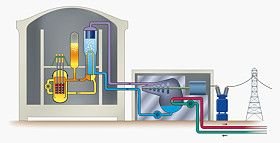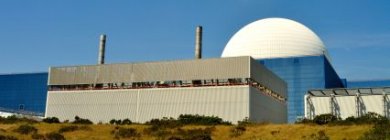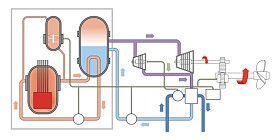- Home
- Nuclear Fission
- Nuclear Reactor
Nuclear Reactor
Control of Uncontrolled Energy
A nuclear reactor offers benefits of huge power output with a relatively small amount of fuel and no waste carbon dioxide. There are some downsides particularly with ensuring safety and the disposal of long-life radioactive waste.
 Czech Republic nuclear power plant
Czech Republic nuclear power plantNuclear waste disposal concerns have resulted in a moratorium on further nuclear power plant construction in the state of California - awaiting a federal government plan for safe storage of waste.
But at least nuclear fission has been proven as a workable means of using a nuclear reaction to produce an alternative form of energy.
Construction
 Diagram of nuclear reactor elements
Diagram of nuclear reactor elementsThe basic construction is similar to a conventional heat-generating fuel source. The fission creates heat which can heat water to drive turbines, creating electricity, or to drive a vehicle.
 Turbine Detail
Turbine DetailTo control the chain reaction that nuclear fission produces nuclear power plants utilise poisons to absorb excess neutrons and moderators to slow the ejected fast neutrons down.
Fuels
Slowing the neutrons down produces hotter neutrons. These interact more effectively with further uranium 235 nuclei.
Faster neutrons will interact more effectively with uranium 238 creating uranium 239 which decays to plutonium 239 which is fissile and a viable reactor fuel.

If we were to rely on uranium 235 there is estimated to be about a hundred years of this isotope available for current generation from current mining. Like trying to estimate oil reserves, this has to be regarded as only indicative and definitely not absolute.
 Uranium mine Saskatchewan, Canada
Uranium mine Saskatchewan, CanadaAlternative Configurations
But using uranium 238 to produce plutonium gives the outlook of millions of years of fuel. These so-called breeder reactors run for decades without the need for refueling.
Bill Gates has lent his reputation to backing this type of reactor. But few exist at present. Also there have been world concerns about other possible uses of plutonium in nuclear weapons production.
 Nuclear reactor at night in Russia
Nuclear reactor at night in RussiaSpent Fuel And Waste
Conventional U235 reactors come to the end of their viable life cycle before all the uranium 235 is exhausted as the poisons utilised to control the reaction prevent full consumption.
And decommissioned reactors have created interesting problems of their own as in the Sizewell one in the UK where cooling water leaked causing some radioactivity to leak into the sea. And if the loss had not been noticed by chance by a worker and all the water had leaked there could have been a more serious fire in the old core.
A similar problem occurred at Fukushima where some of its post-tsunami problems arose from loss of cooling of removed, reactor-exhausted fuel rods.
 Nuclear plant at Sizewell, United Kingdom
Nuclear plant at Sizewell, United KingdomReactor Control
Moderating can be done by water, regular or heavy, graphite rods and a number of other options.
Cooling
Cooling can be by water as well which can as above be used as a moderator.

Generator Fluids
And the water for driving the turbines for power production can either be separated from the cooling part or part of it.
Containment
Some means of containing the whole reactor is needed for protection in the case of problems to contain escaping gases and core materials. Significant accidents have occurred over the years with the US, USSR, and more recently in Japan ones, being the most etched in people's consciousness.
 Nuclear power plant under construction
Nuclear power plant under constructionMany further developments have occurred in reactor design - with containment, moderators, cooling systems and fuel construction all aimed at safer operation and refueling more efficently and effectively.
 Control room of nuclear power station
Control room of nuclear power stationNervousness about the control of reactors and waste disposal continue to limit enthusiastic embracing of nuclear fission as an widespread alternative energy source.
Nuclear Reactors As Engines
 Nuclear-powered submarine reactor schema
Nuclear-powered submarine reactor schemaNuclear reactors have been used for many years in sea vessel applications, mainly naval, although there are some merchant naval ships as well.
 Nuclear-powered submarine Georgia
Nuclear-powered submarine GeorgiaThe advantage of such reactors driving ship and submarine engines is the long time they can remain operational without refueling.
 Nuclear-powered Russian icebreaker
Nuclear-powered Russian icebreakerThe nuclear reactor has many appealing elements. But there are likewise many concerns about major deployment.
- Home
- Nuclear Fission
- Nuclear Reactor
New! Comments
Have your say about what you just read! Leave me a comment in the box below.